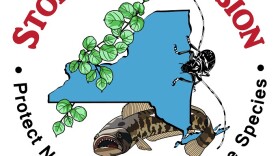The New York State Department of Environmental Conservation confirmed this week that an invasive beetle that kills ash trees has been found in the southern Adirondacks for the first time.
“So as the Emerald Ash Borer bores along that living portion of the inner bark of an ash tree it eventually over time will girdle the ash tree and that’s what really kills the ash tree.” Justin Perry, Chief of the Bureau of Invasive Species and Ecosystem Health with the New York State DEC, says the Emerald Ash Borer was first discovered in western New York state in 2009. Although not unexpected, the discovery of the Emerald Ash Borer at the Warren County Canoe Launch on the Schroon River is the first time the bug has been found in the Adirondacks. “We are still investigating the extent of the infestation. One of the things about the infestation was that it was initially found because of what we call blonding of the ash trees. That’s where the woodpeckers go after the ash borer as it emerges from the tree and it actually knocks the bark off of the side of the tree so it gives the tree a blonde appearance. And that’s usually indicative of the ash borer being present within those trees for a number of years.”
The Adirondack Park Invasive Plant Program, or APIPP, is the umbrella management program for all invasive species impacting the Adirondack region. Manager Tammara Van Ryn says the next step is surveying trees in the area. “You can see there are some ash trees around there that are stressed. Those have not been tested to determine if they have the larvae in them. And so the next step is that the DEC and the Adirondack Park Invasive Plant Program will be going out and doing a survey to figure out how extensive it is. But usually with Emerald Ash Borer by the time you’re seeing the damage it’s not one tree that’s infected. This is probably more than one tree and probably affecting a region around that. How big a region we don’t know yet.”
The DEC says about 7 percent of all trees in the state are ash with a lesser percentage in the Adirondacks. Perry says that’s because the Adirondacks are an older forest and ash tend to get pushed out by the more prevalent shade-tolerant trees. “We’ve known that for some time in the Adirondacks that there is not a huge component of ash. Therefore it is not surprising for us to see that the Adirondack region is one of the last areas to be invaded by the Emerald Ash Borer.”
Van Ryn said APIPP had hoped to be able to keep the Emerald Ash Borer at bay from the Adirondacks. “There may not be a high percentage of ash trees but in the sites where they grow they can be quite prevalent. They tend to be in our lower elevation areas or along our river corridors. So for those sites that do have ash the Emerald Ash Borer does have the potential to basically decimate the ash trees in those locations.”
APIPP’s Van Ryn says the Emerald Ash Borer doesn’t tend to migrate very far on its own. “They really like to be aided by humans. So the way they move most commonly is in firewood. And so the Don’t Move Firewood campaign is still critically important and especially now that we see that infestation in Warren County. I mean the last thing that we want to have happen is someone who’s along the Schroon River who gets some firewood locally there and brings that firewood someplace else and brings Emerald Ash Borer with them.”
The DEC says adult Emerald Ash Borer beetles are between 3/8 to 5/8 inches long with metallic green wing covers and a coppery red or purple abdomen.









